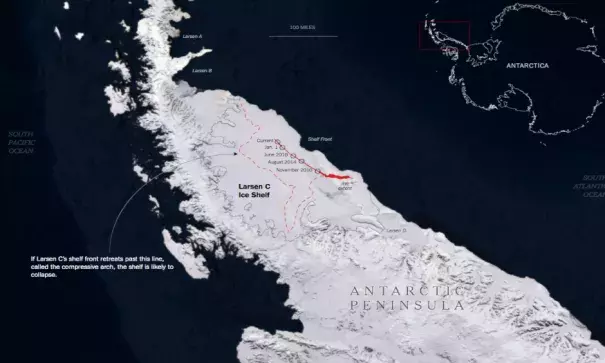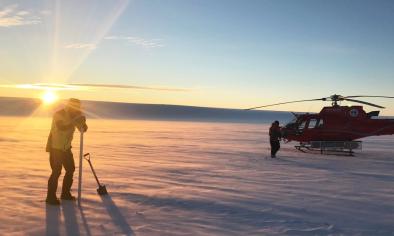A Crack in an Antarctic Ice Shelf Grew 17 Miles in the Last Two Months

A rapidly advancing crack in Antarctica’s fourth-largest ice shelf has scientists concerned that it is getting close to a full break. The rift has accelerated this year in an area already vulnerable to warming temperatures. Since December, the crack has grown by the length of about five football fields each day.
The crack in Larsen C now reaches over 100 miles in length, and some parts of it are as wide as two miles. The tip of the rift is currently only about 20 miles from reaching the other end of the ice shelf.
Once the crack reaches all the way across the ice shelf, the break will create one of the largest icebergs ever recorded, according to Project Midas, a research team that has been monitoring the rift since 2014. Because of the amount of stress the crack is placing on the remaining 20 miles of the shelf, the team expects the break soon.
...
“The iceberg is likely to break free within the next few months,” said Adrian J. Luckman of Swansea University in Wales, who is a lead researcher for Project Midas.
...
Ice shelves, which form through runoff from glaciers, float in water and provide structural support to the glaciers that rest on land. When an ice shelf collapses, the glaciers behind it can accelerate toward the ocean. Higher temperatures in the region are also helping to further the ice shelf’s retreat.
...
The Larsen A and B ice shelves disintegrated in 1995 and 2002, though both were drastically smaller than Larsen C. Neither contributed significantly to global sea level rise, however, because they were already floating above water, and the glaciers behind them did not contain a substantial volume of ice.
According to Dr. Rignot, the collapse of Larsen C would add only a tiny amount of water to the global sea level. Of greater concern to scientists is how the collapse of ice shelves can affect the glaciers that flow behind them, because the melting of those glaciers can cause much higher levels of ocean rise. Scientists see the impending Larsen C collapse as a warning that much larger amounts of ice in West Antarctica could be vulnerable.
Related Content





